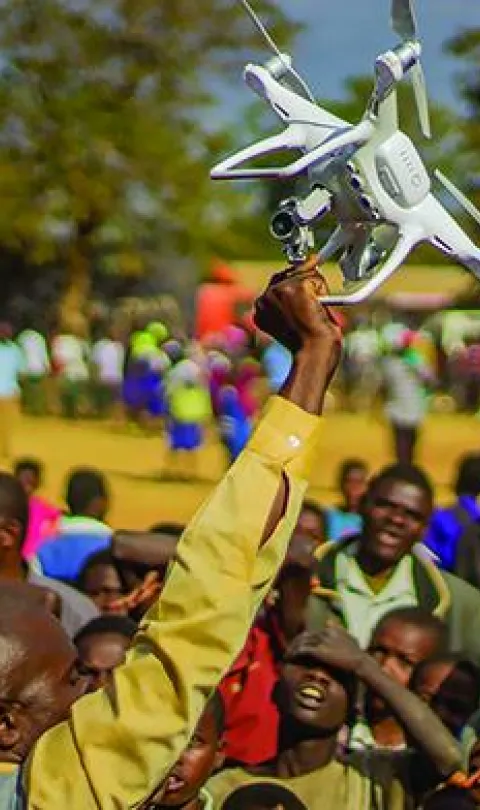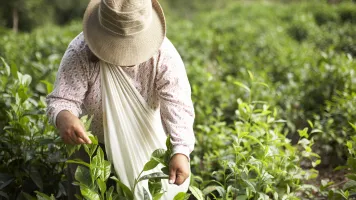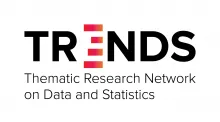This article first appeared in the UN Chronicle, Issues 3&4, 2018. You can read the entire issue: “New Technologies: Where To?
Data is everywhere, constantly being created by humans and machines across the globe. But as half of the world seems to be drowning in data, too many people and places are still invisible in the numbers that drive decisions.
Being counted in the data means you can be better represented by your leadership. It means that policymakers can allocate resources to your needs and you can better advocate for yourself and your community. Being visible and able to see ourselves in the data can be empowering and transformative. When confronted by a set of data, most of us will look first for our city, our community and ourselves. But this is a right denied to too many people. Restricted access to data mirrors other inequalities, and a poor person in a poor country is the most invisible human being there is.
There are gaps in data on people, on places, and in time. Two out of five children in the world aren’t registered at birth, meaning that they are invisible when it comes to planning services to meet their needs. In many countries, remote villages aren’t mapped, meaning that help is slower to arrive when a crisis hits, be that an epidemic, such as Ebola, or a natural disaster. In our age of rapidly developing technology, it is astounding that much of the data being used to monitor the Sustainable Development Goals (SDGs) was collected before the SDGs were even agreed upon.
It is encouraging, therefore, to see the United Nations embracing technology as a tool for positive social change. The Secretary-General’s High-level Panel on Digital Cooperation and his Strategy on New Technologies come at a critical time: we’re approaching 2020, which will mark the 10-year countdown to the SDG target date. As acknowledged in the Dubai Declaration, launched at the Second United Nations World Data Forum in October 2018, the 2030 Agenda’s data demands are urgent and require the power of new data sources and technologies, leveraged through strong, diverse partnerships.
Achievement of the SDGs is a marathon, not a race, but when we’re hitting a wall, game-changing innovations can help us power through with unprecedented speed and scale. One example—the Africa Regional Data Cube—is an initiative that makes 17 years of satellite imagery and Earth observation data available and analysis ready, enabling Ghana, Kenya, Senegal, Sierra Leone and Tanzania to improve agricultural production, monitor and protect the environment, and optimize urban planning for streamlined disaster response, among other things. The Government of Ghana is already using insights from this data to direct teams to sites where, as the data suggests, illegal mining is taking place. This development illustrates how resources can be used more effectively to protect health and the environment in remote parts of the country.
There are plenty of other examples. The drone corridors of the United Nations Children’s Fund (UNICEF) are testing ways of using unmanned aerial vehicles for humanitarian relief, disaster mapping for improved coordination and response, and more. The World Food Programme (WFP) has been using chatbots to monitor food insecurity, a method that is particularly effective in hard-to-reach and conflict-affected areas. With 5G connectivity set to roll out next year, organizations are exploring the benefits that the new standard can have for these and other areas of development, such as humanitarian assistance, and peace and security.
As we develop new and innovative approaches to global challenges, however, it is critical to ensure that countries have strong foundations to build upon. Technology and digital advancements provide new sources of data that are invaluable for sustainable development, but we can only take full advantage of these opportunities if core data systems are working well.
Too many countries simply do not have the resources for comprehensive birth or death registration systems; for mapping fields and houses; and for collecting and sharing information about people’s health and access to water, food and other basic services. Even when investments are made in these areas, many countries are still held back by archaic information technology, poor Internet connectivity, and low-tech data collection processes, which result in information that is not interoperable, sharable or machine-readable.
Funding to meet even these basic data system requirements is falling short. Such foundational needs must be resourced. In the scale of things, the amounts needed are fairly small: the budget gap to improve basic data collection is estimated to be around $200 million, a relatively modest sum compared to other investments needed to achieve transformational change.
Investing in foundational data systems provides the bedrock upon which the innovation necessary to achieve the SDGs can be built. Plus, it saves lives. Investments in basic data collection in the slums of Bangladesh allowed a local non-governmental organization to plan effective health programmes, which brought down the maternal mortality and infant death rate by almost 60 per cent, a much higher rate than in the country overall.Investments in data collection and data sharing using mobile devices across the Ugandan health-care system have reduced the response time for epidemics, improved health monitoring and lowered costs.5
Investments in basic data are a critical part of achieving better outcomes across all of the SDGs. For many of the Governments we work with at the Global Partnership for Sustainable Development Data, better data on agriculture is a huge priority, and donors are beginning to respond. The “50 X 2030” initiative’s financing model commits new money to foundational agriculture data in at least 50 low- and middle-income countries. It allows for alignment with national priorities and for cost sharing with participating countries, which are expected to contribute about $200 million to complement funding from a range of development partners.
The 50 X 2030 initiative, launched at the United Nations General Assembly in September 2018, is a plan to collect the baseline agriculture data that is absolutely critical to achieving SDG 2, to end hunger. Basic information on what farmers are planting, their yields, and access to finance or insurance are often non-existent or patchy at best. As a principal driver of many economies, governments, businesses and the private sector invest hundreds of billions of dollars in agriculture each year. Setting policies without this information leads to inefficiencies that negatively affect agricultural productivity, resulting in hunger and secondary health impacts, such as stunting and malnutrition.
Progress on hunger eradication has been going in the wrong direction for the past three years. In 2017, the number of people facing chronic food deprivation increased to levels reached a decade ago, to 821 million, according to the latest figures. This reversal shows that urgent and coordinated action is needed by United Nations agencies, Member States and donors across all sectors. Such coordination is embedded within the 50 X 2030 plan, which represents a modern picture of development cooperation, moving past traditional north-south models and one-way bilateral financing.
This kind of initiative will better position these countries to use new technology and new sources of data as effectively as possible. As underscored in the Cape Town Global Action Plan for Sustainable Development Data,8 and reiterated in the Dubai Declaration, national statistical offices must transform and modernize. They must be able and unafraid to test new ways of working. They also need strong foundational data collection programmes in place, supported by sufficient resources and multi-stakeholder partnerships to do that. When it comes to data, it is only by bringing everyone along on the journey that we will be able to stay the distance and cross the SDG finish line by 2030.
Notes
1. United Nations World Data Forum, “Dubai Declaration: Supporting the Implementation of the Cape Town Global Action Plan for Sustainable Development Data” (Dubai, October 2018), p. 1. Available at https://undataforum.org/.
2. For more information about the initiative, see http://www.data4sdgs.org/ardc.
3. Global Partnership for Sustainable Development Data, “Making the case: More and Better Financing for Development Data”, p. 5. Available at
http://www.data4sdgs.org/sites/default/files/2018-03/Financing%20for%20Development%20Data%20Pamphlet%20FINAL_27Mar.pdf.
4. Global Partnership for Sustainable Development Data and Thematic Research Network on Data and Statistics (TReNDS), “Bangladeshi Slums Reduce Maternal and Infant Mortality with the Help of Innovative Health Data”, A case study of BRAC’s Manoshi Project prepared by Sustainable Development Solutions Network (SDSN) TReNDS. Available at http://www.data4sdgs.org/sites/default/files/2018-09/BRAC%20CaseStudy_FINAL.pdf.
5. Global Partnership for Sustainable Development Data and Thematic Research Network on Data and Statistics (TReNDS), “Data Sharing via SMS Strengthens Uganda’s Health System”, A case study of mTRAC, Uganda, prepared by Sustainable Development Solutions Network (SDSN) TReNDS. Available at http://www.data4sdgs.org/sites/default/files/2018-09/mTRAC%20CaseStudy_FINAL.pdf.
6. For more information about the “50 X 2030” initiative, see http://www.data4sdgs.org/50by2030.
7. Food and Agriculture Organization of the United Nations and others, The State of Food Security and Nutrition in the World 2018. Building climate resilience for food security and nutrition (Rome, 2018), iii, v, xii, xiii, 2, 3. Available at http://www.fao.org/state-of-food-security-nutrition/en/.
8. High-level Group for Partnership, Coordination and Capacity-Building for Statistics for the 2030 Agenda for Sustainable Development, “Cape Town Action Plan for Sustainable Development Data”, adopted by the UN Statistical Commission at its 48thSession (March, 2017). Available from https://unstats.un.org/sdgs/hlg/cape-town-global-action-plan/.



